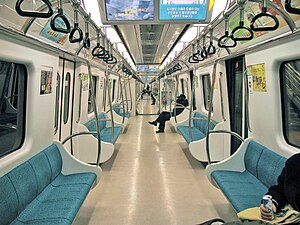

| Daejeon Metro | |||
|---|---|---|---|
 | |||
 | |||
| Overview | |||
| Native name | 대전 도시철도 | ||
| Locale | Daejeon, South Korea | ||
| Transit type | Rapid transit | ||
| Number of lines | 1 | ||
| Number of stations | 22 | ||
| Daily ridership | 110,307 (2019) | ||
| Annual ridership | 40,262,211 (2019)[1] | ||
| Website | http://www.djet.co.kr/ | ||
| Operation | |||
| Began operation | 16 March 2006; 18 years ago (2006-03-16) | ||
| Operator(s) | Daejeon Metropolitan Express Transit Corporation | ||
| Number of vehicles | Hyundai Rotem Metro cars | ||
| Technical | |||
| System length | 22.74 km (14.13 mi) | ||
| Track gauge | 1,435 mm (4 ft 8+1⁄2 in) | ||
| |||
| Daejeon Metro | |
| Hangul | |
|---|---|
| Hanja | |
| Revised Romanization | Daejeon dosicheoldo |
| McCune–Reischauer | Taejŏn tosich'ŏlto |
| |||||||||||||||||||||||||||||||||||||||||||||||||||||||||||||||||||||||||||||||||||||||||||||||||||||||||||||||||||||||||||||||||||||||||||||||||||||||||||||||||||||||||||||||||||||||||||||||||||||||||||||||||||||||||||||||||||||||||||||||||||||||||
This diagram:
| |||||||||||||||||||||||||||||||||||||||||||||||||||||||||||||||||||||||||||||||||||||||||||||||||||||||||||||||||||||||||||||||||||||||||||||||||||||||||||||||||||||||||||||||||||||||||||||||||||||||||||||||||||||||||||||||||||||||||||||||||||||||||
Daejeon Metro (Korean: 대전도시철도; Hanja: 大田都市鐵道; RR: Daejeon dosicheoldo) is the rapid transit system of Daejeon, South Korea, operated by the Daejeon Metropolitan Express Transit Corporation (DjeT, or Daejeon Metro). The single-line subway network first opened in 2006 with 12 stations. The line was expanded in 2007 and it now consists of one line, 22 operating stations, and 22.74 kilometres (14.13 mi) of route.[citation needed]
After the city's administrative district was expanded in 1995, plans were announced in February 1996 for a five-line metro service totaling 102.3 kilometres (63.6 mi). Construction of Line 1 began in October 1996 and was scheduled to be completed by 2003, but completion was delayed by right-of-way acquisition and constrained finances in the wake of the 1997 Asian financial crisis.[2]
| Line Name | Line Name Hangul |
Starting Station(s) | Ending Station(s) | Stations | Total Length in km |
| Line 1 | 1호선 | Panam | Banseok | 22 | 22.7 |
Line 1 was initially designed to be 22.6 kilometres (14.0 mi) long, connecting the old and new town centers.[2] It opened in two phases and a third is planned:
The track leads from Banseok Station in Yuseong-gu to Panam Station in Dong-gu.
Line 2 has gone through a number of changes and proposals over the years, including making it a maglev modeled after the maglev in the National Science Museum.[4] In 2015, a basic plan was established and the following year they announced the route, which included two demonstration routes that would later be connected, one in an urban area and one in a business area.[5] It is still in the planning stage and is expected to open in 2027. Line 2 will be serviced as a tram.[6]
|
| |||||||||||||||||
|---|---|---|---|---|---|---|---|---|---|---|---|---|---|---|---|---|---|
| Seoul Capital Area |
| ||||||||||||||||
| Busan |
| ||||||||||||||||
| Daegu |
| ||||||||||||||||
| Gwangju |
| ||||||||||||||||
| Daejeon |
| ||||||||||||||||
Italics : Under construction | |||||||||||||||||
|
Rapid transit in Asia
| |
|---|---|
| |
| |
|
|
|
|
| |
|
|
|
|
|
|
|
|
|
|
|
|
|
|
|
|
|
|
|
|
|
|
|
|
|
|
|
|
|
|
|
|
|
|
|
|
|
|
|
|
* Under construction. | |
This article relating to rapid transit systems in South Korea is a stub. You can help Wikipedia by expanding it. |